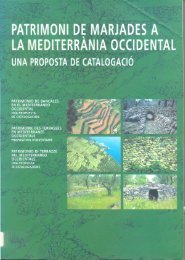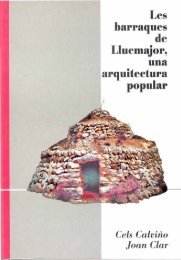La pedra en sec. Materials, eines i tècniques tradicionals a les illes ...
La pedra en sec. Materials, eines i tècniques tradicionals a les illes ...
La pedra en sec. Materials, eines i tècniques tradicionals a les illes ...
You also want an ePaper? Increase the reach of your titles
YUMPU automatically turns print PDFs into web optimized ePapers that Google loves.
*** * ,<br />
* * *: 6 6.1.1 DRYSTONE MASONRY STRUCTURES '<br />
TERRACE WALL<br />
OR RETAINING WALL<br />
Description<br />
Dry stone wall which holds in a <strong>sec</strong>tion<br />
of land.<br />
Uses<br />
Most of the terrace walls on the island<br />
are used to create and hold in agricultural<br />
land 'steps' (terraced fields)<br />
although they have also be<strong>en</strong> used to<br />
hold up tracks and roads and areas of<br />
land where snow is gathered.<br />
Site<br />
Farmland terrace walls are located on<br />
slopes, in valley bottoms and on<br />
plains with diverse morphologies (fluvial,<br />
interfluve, karst, structural) which<br />
have a common need to retain soil<br />
and prev<strong>en</strong>t it being lost to erosion.<br />
<strong>Materials</strong><br />
Limestone is the most commonly<br />
used type of rock in the island's terrace<br />
walls, although they are also built<br />
with <strong>pedra</strong> de blanquer (tanner's<br />
stone), gypsum, sandstone, <strong>pedra</strong><br />
d'esmolar (grinding stone), <strong>pedra</strong><br />
avellanada (hazelnut stone), breccia,<br />
compacted clays, etc.<br />
Size<br />
Farmland terrace walls have be<strong>en</strong><br />
found from 3 to 242m long and betwe<strong>en</strong><br />
0.5 and 6.9 m in height, and taIler<br />
alongside roads.<br />
Route<br />
Terrace walls can follow a straight,<br />
cUNed (concave or convex), winding<br />
or angular route or be made up of differ<strong>en</strong>t<br />
stretches.<br />
Basic construction features<br />
Ass<strong>en</strong>tam<strong>en</strong>t (Seating): the first stones<br />
laid in the tr<strong>en</strong>ch.<br />
Caixa (Box): space betwe<strong>en</strong> the face<br />
and the earth and which is filled with<br />
rubble.<br />
Talus or rost (Talus or slope): slant<br />
built into the retaining wall's facing so<br />
that it has greater resistance to the<br />
materials it holds in.<br />
Reblada (Rubble): small stones which<br />
are placed behind a retaining wall's<br />
facing or betwe<strong>en</strong> it and the <strong>sec</strong>ondary<br />
facing. It is there to improve drainage.<br />
Paredat (Facing/Bond): set of stone<br />
rows which make up the wall.<br />
Coronam<strong>en</strong>t (Crown): method of topping<br />
off the last row in the bond.<br />
Accessory features<br />
Sostreig 0 sostrada : stones laid after<br />
the seating which are used to level off<br />
the wall until it reaches a projection or<br />
tree root which juts out above the<br />
facing. Various types of arches and<br />
lintels are used so that the wall can<br />
continue to be built up with no risk of<br />
collapse.<br />
Capginya (Column): set of stones in<br />
the facing which are laid in the form of<br />
a pilaster and placed on top of each<br />
other vertically, It seNes to separate<br />
the original facing from a collapsed<br />
and repaired <strong>sec</strong>tion so that if with<br />
time one part should collapse this will<br />
not affect the rest of the wall.<br />
Brao (Double facing): double wall<br />
with an internal face separated from<br />
the external one by rubble: the distance<br />
betwe<strong>en</strong> these two faces varies<br />
and the top of the internal face may<br />
ev<strong>en</strong> be exposed if the flat area<br />
behind it is lower. It may ext<strong>en</strong>d up to<br />
the <strong>en</strong>tire height of the retaining wall<br />
or just part of it. It increases the<br />
str<strong>en</strong>gth of the wall, seNes to 'store'<br />
excess stones and prev<strong>en</strong>ts agricultural<br />
work from knocking down the<br />
upper part.<br />
Contrafort (Buttress): reinforcem<strong>en</strong>t<br />
used in very high terrace walls; it does<br />
this acting as a double wall which<br />
•••<br />
162 '




